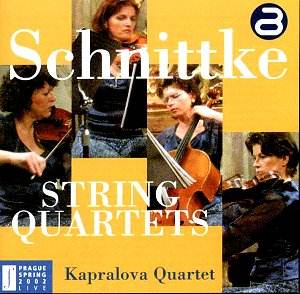The
first thing to note is that these are immensely accomplished performances
made live at the 2002 Prague Spring by the all-female Kapralova
Quartet – who have recorded their namesake’s highly impressive
quartet recently. The second is the complex difficulty of much
of the music. The greatest difficulty lies in the First and for
me least rewarding of these three recorded quartets. The First
dates from 1966 and is a tough atonal work in three movements,
Sonata, Canon and Cadenza. Formally this may seem explicit but
the greater truth underlying the quartet is that it enacts a kind
of catastrophic implosion in which a musical disintegration takes
place before our ears. When it returns the twelve note row re-establishes
a degree of tangible order but what has gone before is frequently
harrowing. There’s plenty of pensive material, abrasive pizzicati
and coruscating drama. Though the Canon utilises a set of variations
one’s ear is drawn to the Cadenza, violently charged and volatile
that leads to the return of the tone row; never had I longed for
one more. This is tough, astringent and demanding music and demands
completely concentrated listening.
The
Third Quartet was written for the legendary Beethoven Quartet
in 1983. It’s in Schnittke’s polystylistic form and establishes
and embraces a kind of historical continuum from Lassus to Shostakovich.
Schnittke quotes from Lassus as he does briefly from Gesualdo
in the opening Andante. Even here, where the material is more
musing and introspective Schnittke is prepared to unleash some
vicious sounding trilling. The Agitato second movement is eager
and vibrant with attractive unison passages alternating with prayerful
Renaissance glints, cumulatively impressive and compellingly moving
in the way he was often moving, as, for example the Viola Concerto.
The finale is by contrast brittle, tense occasionally relaxing,
shadowing Shostakovich. The Fourth Quartet was written in 1986
after his catastrophic stroke and there is a new soundworld here,
one of stillness, refraction and absorption. The sense of concentration
is overwhelming in terms both of material but also of sonority.
He still exploits registral extremes but these demands are not
arbitrary and are securely locked into the emotional fabric and
trajectory of the piece. In the second of the five movements,
an Allegro, there is real bristle and drive, real colour and drama
whereas the succeeding lento is exceptionally complex; time seems
to stand still. The Quartet is based on a slow-fast-slow-fast-slow
pattern and the fast movements can be almost suffocatingly febrile,
fraught and calamitous. It would be easy to read the work as an
autobiography but it makes "sense" in strictly musical
terms as a intensely coiled drama both violent and meditative.
The disc ends with Schnittke’s moving elegy to one of his models,
Stravinsky.
Jonathan
Woolf
The
Arcodiva catalogue is now offered by MusicWeb

![]() for
details
for
details